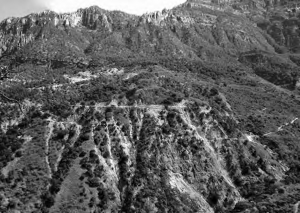VANCOUVER — Armed with long mineralized intercepts and a new metallurgical plan for a big gold-silver deposit in Mexico, Chesapeake Gold (CKG-V) is pushing ahead with exploration and development plans at Metates.
Metates is a large deposit some 175 km northeast of Mazatlan, in Durango state. Cambior drilled 148 holes into the project in the mid-1990s and defined a sizable resource. But then a crashing metals market and a deposit with challenging metallurgy led Cambior to walk away.
Now Chesapeake has confirmed what Cambior found and is starting to expand the deposit. And the company’s management believe they have figured out an extraction process that will give good recoveries at a reasonable cost.
In 2008, Chesapeake drilled 37 holes at Metates totalling 14,415 metres. More than half the holes were twinned ones. The remaining 16 included seven infill holes in a 100-to 200-metre-wide corridor between the intrusive-hosted Main zone and the sedimentary-hosted North zone, as well as nine stepout holes.
All three efforts were successful. The twin holes in the Main zone returned the longest intercepts, such as 552 metres grading 0.78 gram gold per tonne, 18.4 grams silver and 0.19% zinc from 3 metres depth in hole 3. Hole 5 was also collared in the Main zone and returned 383 metres grading 0.99 gram gold, 25.6 grams silver and 0.26% zinc from 6 metres depth. And hole 7 cut 439 metres of 0.88 gram gold, 24.5 grams silver and 0.18% zinc from 4 metres down-hole.
Twinning in the North zone also confirmed Cambior’s results. Hole 17 hit 267 metres averaging 0.84 gram gold, 62.5 grams silver and 0.29% zinc from 18 metres depth, while hole 13 returned 258 metres of 0.64 gram gold, 33.5 grams silver and 0.2% zinc, essentially from surface.
Chesapeake’s infill drilling shows that the corridor between the North and Main zones, which was previously untested, certainly carries mineralization. Drilled in that corridor, hole 24 cut 114 metres grading 0.72 gram gold and 42.4 grams silver from 51 metres depth, and hole 28 returned 222 metres of 0.79 gram gold and 26.8 grams silver from 57 metres.
Three holes tested the downdip extension of the Main zone and all three hit mineralization. The best result came from hole 30, which was collared 100 metres southeast of the zone and cut 129 metres of 0.8 gram gold and 48.2 grams silver from 390 metres depth.
Six holes probed the northwestern and northern extensions of the North zone. Hole 36, a 100-metre stepout along strike northwest of the zone, intercepted 141 metres of 1.03 grams gold and 13.4 grams silver from 117 metres below surface. And directly north of the zone, hole 31 returned 36 metres of 2.69 grams gold and 3.2 grams silver from 351 metres. The North zone remains open to the north, northwest and southwest.
Along strike northwest of the Main zone, hole 32 hit 78 metres of 0.72 gram gold and 17.5 grams silver from 96 metres depth, and hole 34 cut 27 metres averaging 0.8 gram gold and 7.9 grams silver from 174 metres depth. The Main zone remains open to the southeast, but topography limits drilling in that area.
In 1996, Cambior prepared a resource estimate for Metates, which is not compliant with National Instrument 43-101 standards. The unclassified resource came in at 823 million tonnes grading 0.62 gram gold, 15 grams silver and 0.16% zinc, which put contained gold at over 16 million oz. The problem is that the mineralization is refractory, which means recoveries are very poor using conventional cyanide leaching.
Last year, Chesapeake examined seven processing options for Metates ore and explained the results in a technical report. The analysis determined that the best option is to produce a sulphide concentrate using flotation, roast the concentrate, and then use cyanide leaching to extract the precious metals. One advantage of roasting is that the process produces concentrated sulphuric acid as a byproduct.
And it turns out the impact of a sulphuric acid byproduct stream is significant. Assuming a 30,000-tonne-per-day operation, the processing-only cash cost is between US$300 and US$350 per oz. gold equivalent. However, if half of the 5,000 tonnes of sulphuric acid produced each day is sold at US$80 per tonne and the other half neutralized at US$10 per tonne, the processing-only cash cost per oz. gold equivalent drops to between US$100 and US$150. And the market price of sulphuric acid is currently around US$325 per tonne.
Co-generated electrical power and possibly the recovery of saleable zinc could further reduce costs, something that will become clearer in the upcoming preliminary economic assessment. For that report, Chesapeake expects to scale up the processing rate to around 65,000 tonnes per day, given the size of the deposit at Metates. The company hopes to have that assessment complete by the end of the year.
At presstime, Chesapeake shares traded near $3.10. The company has a 52-week trading range of $1.89-7.84 and has 38 million shares outstanding.


Be the first to comment on "Chesapeake Mulls Options At Metates"